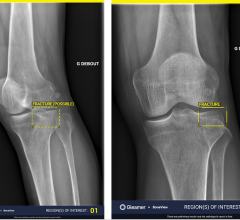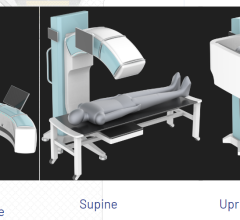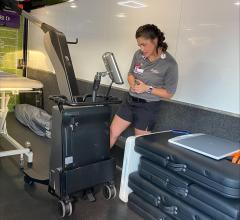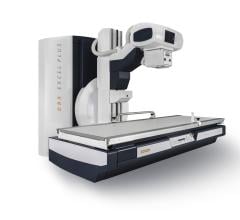
The Canon CXDI-50G is a portable DR system that provides high-
When diagnosing trauma patients, speed and accuracy is essential. As a result, emergency room physicians are increasingly turning to computed radiography (CR) and digital radiography (DR) combined with an integrated picture archiving and communication system (PACS) when triaging patients. The move from traditional film to digital X-ray makes the images immediately available to doctors anywhere in the hospital, or even on computers outside the hospital. Reshoots for over or under exposure can also be corrected electronically instead of having to shoot the image again. The move to digital can also save large amounts of time and money. A 2007 Frost and Sullivan study evaluating the U.S. and European digital radiography markets shows traditional film radiography is the largest cost contributor and one of the most inefficient components for radiology departments. The report’s authors say digital radiography has the ability to provide big, long-term savings. Both CR and DR expedite triage in the ER by providing digital X-ray images quicker than film screen X-ray. CR systems currently boast a lower cost and are easy to use. However, many users believe DR may eclipse CR as the preferred X-ray option because it is much faster, higher quality, does not require removable cassettes and uses a lower radiation dose. Many hospitals initially converted from film screen to CR because it is cheaper than DR and they can just retrofit their old X-ray equipment using CR cassettes. CR is frequently used as a steppingstone to DR technology, as was the case about four years ago at NCH Healthcare System’s Naples Community Hospital in Naples, FL. Rene Quick, RTR, clinical student supervisor for the Department of Radiology, said the hospital ran into issues integrating CR with their PACS system, but resolved the problem by converting almost completely to DR about three years ago. She said the CR machines are now reserved as backup and see use in the OR. Quick said CR was not much faster than using film and it took about a minute to load an image into the system, where as DR only takes three seconds. The time difference means a lot, since the ER conducts 66,000 imaging procedures annually. “The time savings is the biggest aspect everyone likes,” she said of DR. Naples Community Hospital’s ER has two Canon CXDI-40G general DR systems with an imaging area of 17-by-17 inches. One has a panel mounted on the wall and the second is in a table. The ER also uses a lightweight, mobile Canon CXDI-50G DR with a 17-by-14-inch panel on a movable arm. Quick said the mobile unit is primarily used for trauma patients so they don’t have to be moved, allowing doctors to view images immediately after they are shot in the room with the patient. The speed of DR combined with the elimination of darkrooms, darkroom technicians, film, chemicals, film storage, and file room clerks, has saved the hospital significant amounts of money. Quick also said patient waiting times have decreased. “Over time the machines absolutely will pay for themselves,” she said. CR and DR can also help older hospital ERs, which were not originally designed or have the space for the large volumes of patients they see today. This was the case of St. Joseph’s Hospital Health Center in Syracuse, NY, which annually performs 37,000 ER imaging procedures. Radiology was located two floors above the ER, which ate up a lot of staff time due to transport and waiting for images. To increase speed and efficiency, the hospital went from film to a completely digital PACS system in 2005 and installed CR and DR equipment in the ER. The ER gave up space to accommodate a Carestream CR 975 multireader, a Carestream DR 9500, and a Carestream DR 7500, which is on order. The 9500 and 7500 have a 17-by-17-inch detector size, and the 975 uses cassettes up to a size of 13.75-by-17 inches. Robert Whitmarsh, RT (R) CNMT, manager of St. Joseph’s medical imaging, said the loss of space has been worth it, with large amounts of time saved in transport and imaging times. Even with the loss of ER space, he said efficiency has increased, so patient waiting times have dropped. Comparing the CR and DR machines working side-by-side, Whitmarsh said DR is hands down the best technology. He said his DR system has as much clarity as film, and when compared to CR is faster, has better image quality and uses a lower radiation dose. He also argues that while the purchasing cost of CR is cheaper than DR, there is a cost savings with DR in the long run. “CR is still faster than film screen,” he said. “But, DR is where you are going to get the biggest speed advantage. DR is so much faster than CR that it has actually allowed me to reduce the number of X-ray rooms we have.” Whitmarsh cut the overall number of X-ray rooms from seven to six, eliminating one full-time technologist position. He said similar to film, CR requires a new cassette to be used for each patient. He said the hospital used more than 50 cassettes, cost about $1,200 each, which wore out every one to three years. An unforeseen downside of DR’s decreased time to image and elimination of consumables and the darkroom, has been the tendency of technologists to reshoot images. This exposes patients to more radiation than they used to using film. “If an image is not quite right they have a ‘well let’s shoot it again’ mentality, because it is so much easier to shoot,” Quick said. However, Whitmarsh said his department overcame this issue by using the DR technology’s ability to capture all the information from each exposure to generate downloadable reports. He used this information to analyze radiation exposure levels used by each technologist to reveal who had the highest “exposure creep.” The imaging department posted these statistics and then set target radiation doses it challenged the staff to meet. “They didn’t like being the ones who were over target and they worked to reduce the exposure amount,” Whitmarsh said. However, as with many new innovations in technology, change is sometimes a tough pill for clinicians to swallow. St. Joseph's was the first of the five hospitals in Syracuse to go completely digital with a PACS system. Whitmarsh said there was a lot of resistance from doctors who were used to viewing X-rays on film, not via a CD they had to load onto the computer. The hospital has sent members of its staff out to doctor’s offices as consultants to explain why going digital is a good idea by saving time and money. He said the positive message has been received from some, including one doctor who said remote access to the hospital's PACS system saves him so much time that he can see more patients each day, making his business more profitable than before. To optimize the benefits of DR technology Whitmarsh said hospitals may have to change how they operate. “We really modified our workflow to take advantage of the technology, instead of forcing it to match our old workflow,” he said. Quick said any conversion to new technology in a hospital is difficult and resistance is expected from staff who worked with an older technology for years. Her best advice to hospitals converting to CR, DR and PACS technology is to stress training so people fully understand how the equipment works. “Make sure everyone is well educated, otherwise that’s where the frustration sets in - when their computers don’t work,” she said.



 November 26, 2025
November 26, 2025 








